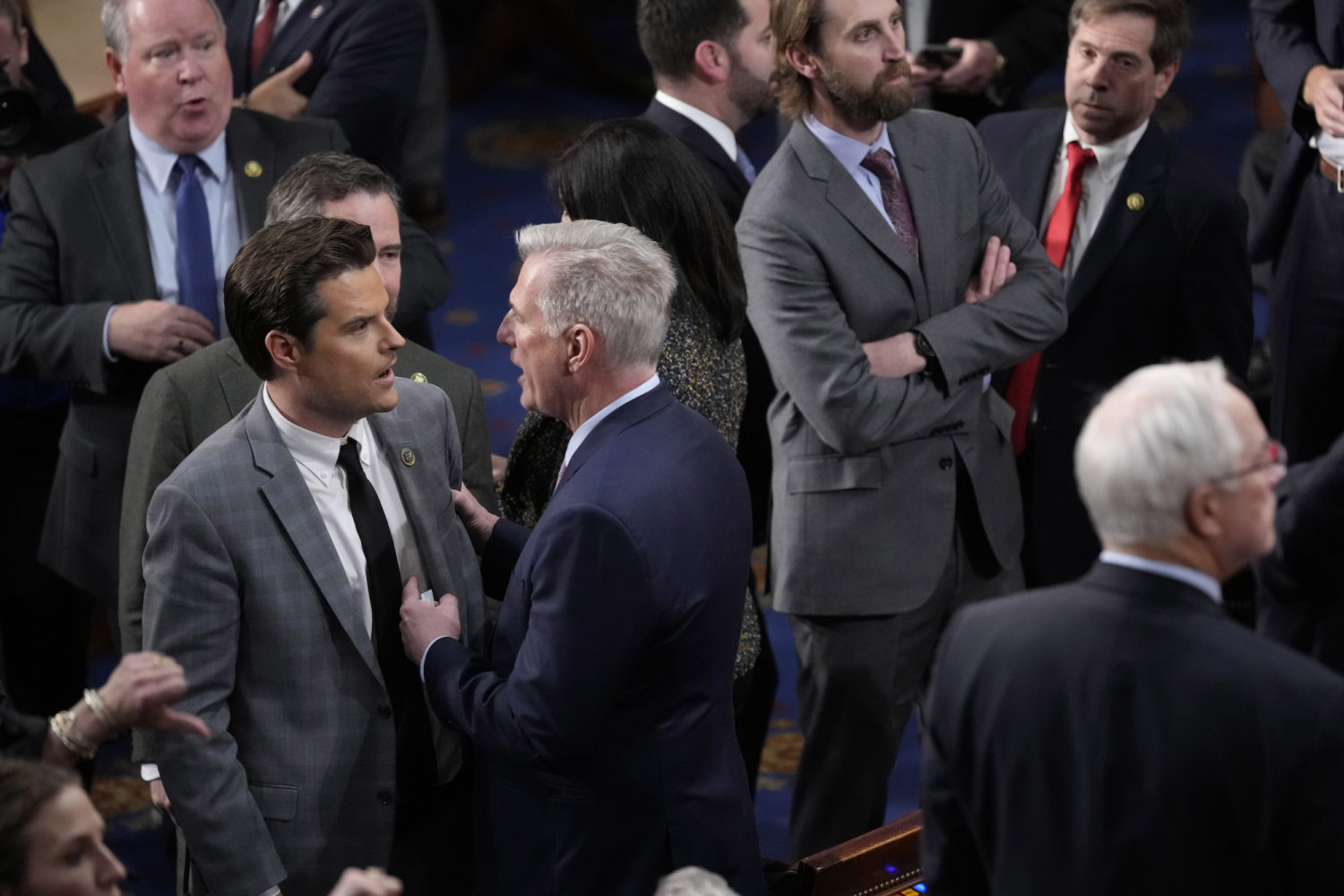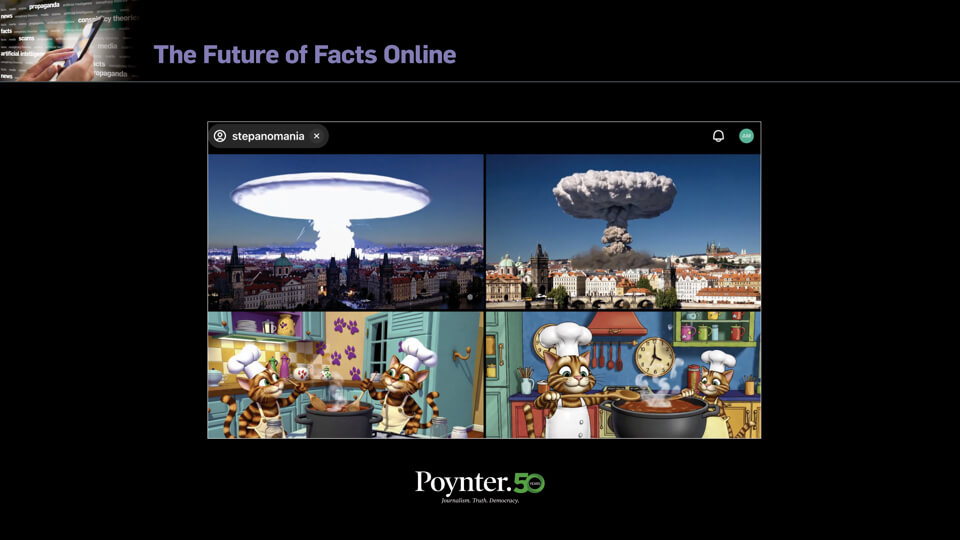Social media was ablaze last week as people hungrily consumed C-SPAN’s coverage of Rep. Kevin McCarthy slogging his way to becoming the 55th speaker of the U.S. House of Representatives.
Because the House couldn’t approve a rules package without a speaker, the public service channel’s cameras were free to roam the floor, and Americans got to see much more than the often uneventful wide-shot angle of the House floor.
They saw chaos and legislators milling around. They saw Republican Rep. Paul Gosar of Arizona in conversation with Democratic Rep. Alexandria Ocasio-Cortez, surprising because he was once censured for tweeting an animated video depicting himself killing her. Then, of course, there was the tense moment when McCarthy confronted a seated Rep. Matt Gaetz during the 14th vote. Shortly after, Rep. Mike Rogers of Alabama stepped toward Gaetz and had to be restrained.
Throughout the votes, some — including journalists — shared appreciation of C-SPAN’s cameras:
- USA Today columnist Connie Schultz tweeted: “I am grateful for @cspan’s coverage this week. Free of archaic rules of coverage, its dedicated photographers and staff are giving America a truer view of leadership, and the lack of it.”
- Maxwell Alejandro Frost, Congress’ first Gen Z member, tweeted: “I think C-SPAN should keep control of the cameras on the house floor. It makes our democracy more accessible, understandable, and exciting. Let the people see Democracy in action. #FreeCSPAN”
- Ed O’Keefe, senior White House and political correspondent for CBS News, tweeted: “No matter what you make of this, two groups of people deserve big thanks: The Office of the House Clerk staff and our good friends at @cspan manning the TV cameras and capturing all these great moments across the House floor we don’t normally get to see.”
- Gaetz himself told Fox News he was introducing an amendment to the House to allow C-SPAN cameras on the chamber floor.
- Even Jon Stewart chimed in, tweeting: “This is the best season of cspan…ever.”
“I think we are still coming down off a high from last week,” Ben O’Connell, C-SPAN’s director of editorial operations, told Poynter Thursday. “It was like nothing that most of us have ever experienced, certainly not in our careers at C-SPAN.” For O’Connell, that’s almost 22 years.
C-SPAN co-CEO Susan Swain on Tuesday sent a letter to Speaker McCarthy seeking ongoing access to the House chamber. “The public, press, and Member reaction to C-SPAN’s coverage — along with the “transparency” themes in your new rules package — have encouraged us to resubmit a request we have made to your predecessors without success: Allow C-SPAN to cover House floor proceedings on behalf of our network and all Congressionally-accredited news organizations,” the letter read, in part.
C-SPAN has for years pushed for greater public access to the government. Its latest letter requested the network be able to put a few cameras into the chamber to supplement what’s known as the House Recording Studio feed. “That feed is what people would watch when they normally tune into C-SPAN for day-to-day legislative House session,” O’Connell said.
Swain’s letter to McCarthy says that C-SPAN is not proposing to replace the existing House Recording System or its output, only to install a few additional cameras. O’Connell said the House Recording Studio’s feed operates under very strict guidelines: they’re only able to show the person speaking at the microphone, wide shots, and are not allowed to show reaction shots, close-ups of anyone who is not speaking, the groups of members wandering the floor and negotiating with one another, or anyone in the back of the chamber.
“We want to be able to supplement that feed with our cameras in order to really put viewers in the room, to show them all of the interactions that are happening to the best of our ability, to tell the story of at least the major legislation as it’s moving through the House,” he said. “If the speaker isn’t comfortable with allowing us full access, we asked that they at least consider allowing our cameras for the big bills.”
A sentiment from many viewers appears to be that more access would be good for transparency — that we can see democracy in action. Poynter senior faculty Al Tompkins said you only have to look at what occurred last week to see the value in being able to see what’s actually happening on the floor.
“When we’re watching C-SPAN, we always get this notion that everything’s already been decided and everything’s already worked out, nobody’s being persuaded by anything. What made that whole speakership drama so interesting is that, in fact, it wasn’t decided,” Tompkins said. “What we saw was something that was completely unscripted. It made it interesting, but by the way, it was also third in line to the presidency. It’s not a small thing.”
Tompkins argued that more cameras on the House floor would show that a lot of what goes on is, in fact, theatrical.
“Sometimes people are worried that cameras, for example in the courtrooms, will urge people to be theatrical,” he said. “You don’t have to urge members of the House to be theatrical. They’re already theatrical. What we would get though, is the context of the fact that very often, they’re speaking to nobody. They’re just speaking for the record.”
Allowing C-SPAN cameras would bring context, Tompkins said. “You trust anything more if you get context,” he added.
Inae Oh, senior news and engagement editor at Mother Jones, published a case this week against what she called the “C-SPAN gaze.” “The chance of getting zoomed in on by a C-SPAN camera would also play to some of the worst instincts that animated the very grandstanders responsible for last week’s Republican paralysis,” she wrote.
In her piece, Oh wrote that those who run this country obsess over ways to make headlines. She name-dropped Democratic Rep. Katie Porter as having emerged with “what might be the best possible argument against a free-roaming C-SPAN,” with a tweet of a photo of Porter reading “The Subtle Art of Not Giving a F***” on the House floor.
In a call with Poynter, Oh said she doesn’t know what context would be added if the public network were allowed greater access. She questioned if we needed to see Gaetz and Gosar speaking with Ocasio-Cortez.
“I don’t know what that offers the American public. There were some genuine moments that emerged last week. Not everything was contrived, but I don’t think much was gained from that,” Oh said. “These people were going to oppose Kevin McCarthy and humiliate him for days regardless of cameras or not. I don’t know what cameras provided other than entertainment.”
Oh argued that she doesn’t think substantial value comes out of more cameras on lawmakers she described as obsessed with their own performance.
“There’s cable news. There’s social media,” she said. “I don’t see why we would bring yet another medium for fighting and for grandstanding.”
O’Connell said that the existing setup is akin to a government agency covering the House of Representatives.
“We have a government covering the government,” he said. “I think allowing disinterested journalists to man the cameras, or at least supplement the feed provided by that office, would be a great move towards transparency — and would allow Americans at home to see their members of Congress working on the House floor in a way that they never have before.”






